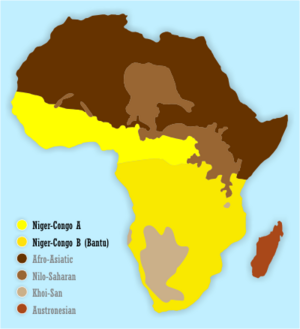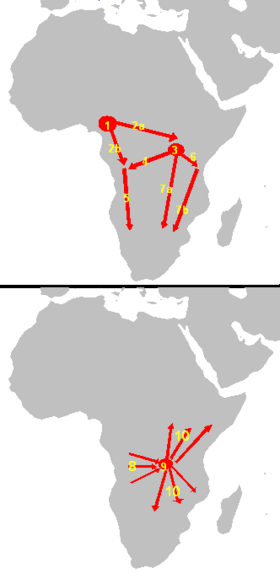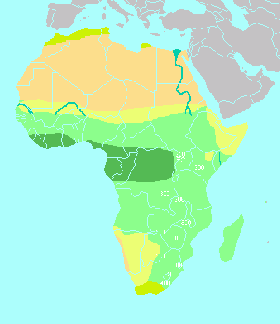Bantu
Bantu is a general term for over 400 different ethnic groups in Africa, from Cameroon, Southern Africa, Central Africa, to Eastern Africa, united by a common language family (the Bantu languages) and in many cases common customs.
Definition
"Bantu" means "people" in many Bantu languages. Dr. Wilhelm Bleek first used the term "Bantu" in its current sense in his 1862 book A Comparative Grammar of South African Languages, in which he hypothesized that a vast number of languages located across central, southern, eastern, and western Africa shared so many characteristics that they must be part of a single language group. This basic thesis is still accepted by some people today, although the theory has been widely challenged since it was proposed – not least because a language may be spread by a relatively small number of human carriers.
Origins
Before the Bantu, the southern half of Africa is believed to have been populated by Khoisan speaking people, today occupying the arid regions around the Kalahari and a few isolated pockets in Tanzania; whereas Cushites, Nilotes and other people speaking Afro-Asiatic languages inhabited north-eastern and northern Africa. Northwestern Africa, the Sahara, and the Sudan were inhabited by people speaking Mande and Atlantic languages (such as the Fulani and Wolof) and other people speaking Nilo-Saharan languages.
There are two basic theories of Bantu origins. The first was advanced by Joseph Greenberg in 1963. He had analyzed and compared several hundred African languages and found that a group of languages spoken in Southeastern Nigeria were the most closely related to languages from the Bantu group. He theorized that Proto-Bantu (the hypothetical ancestor of the Bantu languages) was originally one of these languages that spread south and east over hundreds of years.
This was quickly challenged by Malcolm Guthrie who analyzed each Bantu language and found that the most stereotypical were those spoken in Zambia and in the southern Democratic Republic of Congo (DRC). This provided the alternative theory that Bantu speakers had spread from this location in all directions.
Bantu expansion
The Bantu expansion was not so much a physical migration as it was a natural spread of language and knowledge throughout different populations, and societal groups (usually through inter-marriage or by small groups moving to new areas).
By about 1000 C.E. it had reached modern day Zimbabwe and South Africa. In Zimbabwe a major southern hemisphere empire was established, with its capital at Great Zimbabwe. It controlled trading routes from South Africa to north of the Zambezi, trading gold, copper, precious stones, animal hides, ivory and metal goods with the Arab traders of the Swahili coast. By the 14th or 15th centuries the Empire had collapsed, with the city of Great Zimbabwe being abandoned.
Another theory held is that the Bantu originated from the Congo and due to factors like agriculture, trade in ivory they spread out to the north, east and the south. With slave trade the further scattered out across Africa some running from the slave traders. It has to be noted that although the Arabs were the main slave merchants some chiefs widely participated in the rise of slave trade as they sold on to the Arabs any captured prisoners of tribal clashes.
Bantu in South Africa
Black South Africans were at times officially called "Bantus" by the apartheid regime.The term is derived from the Zulu term for people "abantu" the plural of "umuntu" . Examples of its usage are as follows 1.One of South Africa's politicians of recent times General Bantubonke Harrington Holomisa " all the people" who is know as Bantu Holomisa . 2. The South African apartheid regime, used the term "Bantustan", to refer to Black homelands (Transkei, Bophuthatswana, Venda and the Ciskei) which included both Nguni & non-Nguni speaking blackSouth Africans 3. "Ubuntu" to be human
Bibliography
- J. Desmond Clark, The Prehistory of Africa, Thames and Hudson, 1970
- April A. Gordon and Donald L. Gordon, Understanding Contemporary Africa, Lynne Riener, London, 1996
- Kevin Shillington, History of Africa, St. Martin's Press, New York, 1995 (1989)
See also
- Centre International des Civilisations Bantu
- Jan Vansina
- Candomblé Bantu
- Somali Bantu
ReferencesISBN links support NWE through referral fees
Credits
New World Encyclopedia writers and editors rewrote and completed the Wikipedia article in accordance with New World Encyclopedia standards. This article abides by terms of the Creative Commons CC-by-sa 3.0 License (CC-by-sa), which may be used and disseminated with proper attribution. Credit is due under the terms of this license that can reference both the New World Encyclopedia contributors and the selfless volunteer contributors of the Wikimedia Foundation. To cite this article click here for a list of acceptable citing formats.The history of earlier contributions by wikipedians is accessible to researchers here:
The history of this article since it was imported to New World Encyclopedia:
Note: Some restrictions may apply to use of individual images which are separately licensed.


